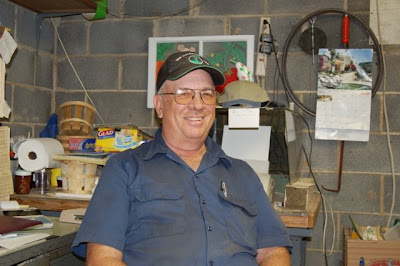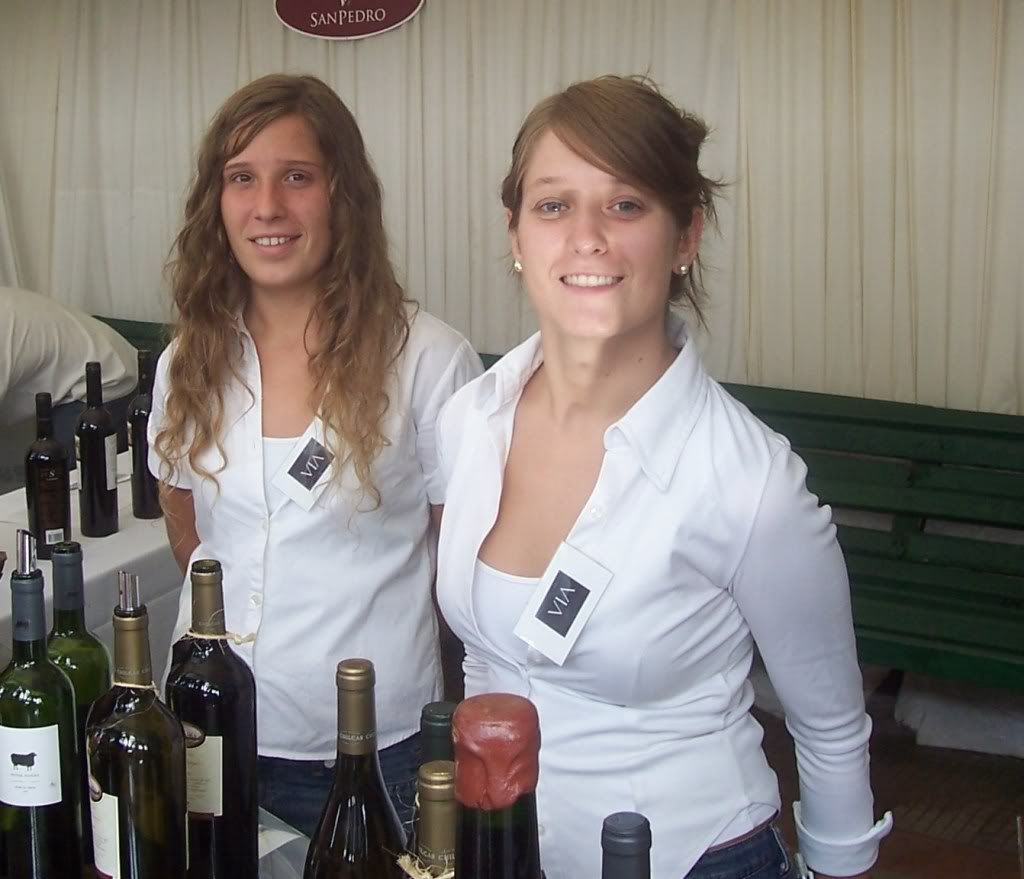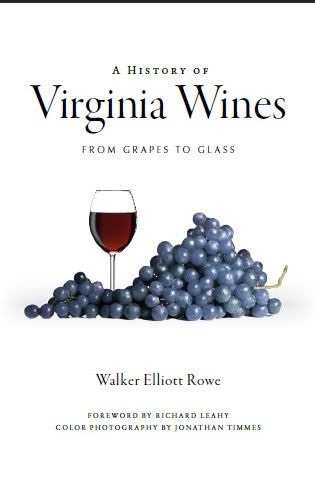

I got my chandler strawberry plants from Lois’s produce in the tidewater part of
The driveway leading up to Lois’s produce is lined with a ditch on one side and fields of overripe tomatoes on the other. Out front a 1958 rusted Allison Harvester tractor marks the entrance to the farm. Turn left from the driveway and there sits a line of old refrigerated tractor trailer truckers, called “reefers”, a pesticide sprayer, and an old van used to haul produce to the farmers market. The main building here among the tangle of sheds, shacks, and greenhouses was a double wide mobile home trailer. An old blue tick hound land in the sand out front of the office swatting away flies with his tail while an air conditioner hummed audibly.
Inside the office at Lois’s produce Lois Allensworth sits behind her desk. It is covered with bills from the chemical man and farmer’s cooperative. A calendar from 1968 hangs on the wall. The desk is a metal ordinary green desk with a calculator and seed catalogues and technical literature from Virginia Tech,
Lois sat back in a chair that squeaked as she turned to the door to face her husband Gary as he walked in the door. He is a tall fellow about 6 feet two with gray hair and weathered skin that has been wrinkled from long days looking up to the sky. Like the clichéd view of long married couple he and his wife looked fairly alike. And like another cliché they looked a little like their dog who raised one lazy ear and eye to see who was coming onto the farm. Bored at what he found, he rolled over and went back to sleep in the lazy sunshine.
The cicadas sang and filled the air on this hazy august day in the Northern Neck region of
Lois and Gary farm 120 acres of vegetables on land that has been in Lois’s family for 4 generations. They sell their produce to a wholesalers association which in turn sells produce to Giant and Safeway grocers. Lois and Gary had built the wholesalers association together with 15 other farmers with a grant obtained from the state.
The vegetables here were grown conventionally where the word “conventional” means “not organic” or what the organic crowd disparagingly calls “chemical farming”. Nothing is wrong with that; it is what the great majority of farmers do. Lois and Gary understand organic agriculture but have opted instead for conventional farming. They have their own opinion of organic farmers.
Lois says she knows no other vocation beyond farming and could think of no other more pleasant way to spend her days. Looking whimsically back at the past she said, “I’ve been doing vegetables all my life because my dad did it. There used to be packing houses all over the northern neck. They’re all gone now.”
While many of their neighbors had giving up on produce in favor of row crops like soybeans and corn or tobacco Lois and Gary continued to earn a generous living with vegetables even if they characterized farming as “warfare”.
Tomatoes are a labor intensive crop. Each plant is worked like a grape vine---it must be staked and tied and suckers popped off. And an automatic harvesting machine is prohibitively expensive so boxes of tomatoes are harvested by hand.
The tomatoes grown on the farm here are the hybrids so popular with growers and the average buyers. These were cross bred for extended shelf life and reasonable taste but even when picked ripe they do not have the succulent taste of the so-called heirloom varieties whose vines tend to sprawl rather than grown uniform and tall like the beefeater and other varieties. Geneticists have stepped into the debate over what tomato tastes best. One of the first genetically engineered crops was the Flavor-Savor tomato. It was supposed to last longer on the grocer’s shelf and thus be able to be shipped long distances. But it was a financial flop and it did not taste much better than regular hybrid tomatoes and worse it did not even last much longer on the shelf.
Another mainstay at Lois’s produce is sweet corn. Most people do not realize that 95 percent of the corn grown in the
Sweet corn like strawberries are products of selective breeding and are much different from their genetic ancestors. Much of the corn that people eat is bred and genetically engineered to push the plant to produce lots of sugar. Such technology is not given away for free and so-called “triple sweet varieties” made by companies such as Syngenta are patented.
One problem with growing corn is the number of pests that attack it. Deer love it. Raccoons are perhaps the biggest problem for the backyard gardener. But a bigger menace is a smaller creature: the worm.
Much has been written about so-called genetically engineers Round-Up Ready corn meaning corn that has been genetically engineered with the ability to tolerate the glysophate herbicide. This lets the farmer no-till his soil, thus cutting down on soil erosion, mow down the weeds with mowers or herbicides, sow his feeds, and then spray Round-Up over the top of the plants after the corn gets up a few inches. Because the corn is Round-Up Ready it thrives while the broadleaf weeds and grasses die. Thus the corn is free to grow without competition for water and nutrients---mainly nitrogen---from fescue, morning glories, lambsquarter, pigsweed, and other.
Another type of genetically engineered crop is BT corn. This is corn that is cross bred to include genes from the bacillus thuringiensis or “BT” bacteria. BT is popular with organic farmers so one wonders why the organic farmers are opposed to this type of genetic engineering. BT has been used by farmers worldwide for more than 100 years. It is a bacteria that when consumed by worms literally eats them from inside. The bacteria multiply inside the worm and then eat their way out of their host. So the worm dies.
But BT corn is no panacea. The problem is the worms—corn earn worm and beet army worms--start at the silk of the corn and begin to eat the growing ear. It takes some time for BT to do its magic. The result is the end of the ear of corn is full of holes. Lois says buyers in the grocery store every time will choose the chemically farmed ear of corn which has been sprayed with pesticide because it can be free of any blemishes at all. The organically-grown corn will have had its end gnawed off unless something beside BT is used to protect it.
The other difficulties with corn include its thirst for water. Lois says, “You can’t afford to grow corm with irrigation. You cannot afford to grow it without irrigation.” By this she means drought will stop the corn from developing marketable sized ears and the cost of irrigation means you can hardly make a profit. There are two types of irrigation: drip and pivot. Drip means the field is rigged with hoses, regulators, and valves that drip irrigation onto the field until the soil is saturated. But that is done mainly for grapes, strawberries, tomatoes, and other crops. With corn more common is the so-called “pivot”. This is a giant arm that rides on huge tires across the field powered by a diesel engine or three phase electricity. Diesel of course is expensive and three phase electricity is not available in all rural areas. Gary and Lois told a funny story about a farmer who use the pivot. He forgot to watch his equipment and came back the next day to find it had driven itself into the woods.
Driving around the farm looking at fields
Like the growers in California Gary and Lois fumigate the soil with a gas called ethyl bromide when they plant strawberries. Farmers are looking for a substitute since ethyl bromide has recently been banned by international treaty since it is blamed for ozone layer depletion. Ethyl bromide
Deer are a problem for the strawberry crop. He says least year he put floating row covers on them because the deer were eating them up. The side affect of this was it warmed up the fruit so they were able to bring the fruit to market a bit earlier in April.
I ask
His opinion of organic farming is, “If it’s perfectly clean and they say it’s organic they’re pulling your leg. They’ll pay twice as much money for it if it is organic.” He asks, “How organic is it?”
We drive around the farm some more and with each crop we pass
He tried twice to plant cucumbers that year. We have not been able to plant cucumbers this year. I planted them too early. The first crop died. He planted them a second time and then they had a long dry spell and they too died.
I leave the farm with a basketful of elephant garlic to plant in my own garden. Gary and Lois have their garlic laid out on a table in a greenhouse where it is drying. The heat in there is stifling. You plant garlic in the fall and harvest them 220 days later.
I had gone to see Lois and Gary so I could document how conventional farmers use farm chemicals and to compare this with what I was doing with my grape farmer. So when I got home I looked up technical literature on the chemical Warrior that
The literature says the insecticide Warrior contains the synthetic compound pyrethroid which is similar to the natural chemical pyrethrin. Organic farmers use pyrethrin but not pyrethroid since that is manmade which would violate the rules of organic farming. The Warrior product brochure from Syngenta says, “Centuries ago Chinese farmers made an insecticidal powder by grinding up chrysanthemum flower petals, which contained natural pyrethrin insecticides. Scientists isolated pyrethrins in 1910, and synthesized the first pyrethroid—a laboratory analogue of pyrethrins---in 1945.” It is a broad spectrum pesticide meaning it targets most insects including the beneficials. For this reason Syngenta has added a chemical which repels bees. Pyrethrin is rapidly broken down by sunlight so its impact on the environment is slight.
Warrior is a restricted use pesticide which means you need an applicators license to buy it. The product label says “may be fatal if swallowed” as well as “This pesticide is extremely toxic to fish and aquatic organisms and toxic to wildlife.” That’s fairly shocking for something that comes from something that comes from nature. But there are lots of natural products that are toxic like arsenic for example. This is why you have to go beyond the hyperbole to find out what is truly better: organic farming or chemical or some wise combination of the two.
Back at my own farm as I write this the
Continue Reading...

















